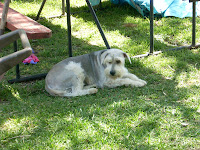Sunday, October 11, 2009
Tuesday, August 25, 2009
The Story pg.3
We never knew if our foundling, WB, was a he or a she. But, because we connected his arriving with our son's leaving for Air Force boot camp, we always called it Wille or He. And he was given a room of his own. From the very beginning it was our hope that WB would grow, learn to eat and drink, fly, and some day be released to return to the sky with all of the other swallows that travel to and from this part of South Texas. Just as we had encouraged our own two children as they grew to be independent and self-sufficient, we knew it would be best for WB. So, we designated a room in our house for WB. His nest consisted of old cotton rags arranged in a small laundry basket. The basket was then set by an open window near other mud swallow nests. We were hoping this would encourage his vocalizing so that he would sound like the other swallows. We also left a radio playing softly nearby.....no not classical music to encourage the growth of his tiny brain.... probably our local country-western station to keep him company when we weren't home. Every time we would walk into that room he would throw back his head and strain his tiny beak open as wide as possible, bobbing up and down, in hopes a small morsel of wet cat food would land in it. During the first few days we avoided going into WB's room too often, even though we wanted to sit by his basket and just watch what he was doing. We felt like too much handling wouldn't be good for him. His first days were mostly sleeping and eating and bobbing with blind eyes, still covered with transparent eyelids. He grew quickly, his body thickened and lengthened. And the first evidence of feathers appeared. Have you ever watched feathers grow on a bird? We hadn't and we were amazed at what we saw.
Friday, August 21, 2009
The Story pg.2

And what were we going to do about this? A baby bird to raise? Baby bird described is: no more than a day old, eyes still closed, absolutely no feathers, not even pin feathers, purplish pink wrinkled skin that is wiggling and opening its yellow edged mouth. After talking about it for a few minutes we decided we would give it a try. Fortunately cousins Walt and Martha had experience in raising baby birds they had shared with us so we had an idea of where to start. First was to be sure the baby was warm. Next to get it to eat.
Not being ornithologists and with absolutely no visible clues on WB as to what kind of bird we had, we just had to guess about food. W and M had explained how they would take dried cat food and soak it in water to feed their young birds, so that was what we decided to do. But how do you convince a one day old bird to open its mouth to take the food. Holding it near, tapping it on the beak didn't work. Pops solution was to scoop a little food on an orange stick (you ladies know what that is) and pry the baby's beak open. It took only two or three times before WB knew exactly what the tap on his beak and our voices was all about. Within a day all that was needed was for one of us to say something and that little beak flew open, anticipating another morsel. Feeding for the first week was around the clock. We fed every 2-3 hours and WB thrived.
Wednesday, August 19, 2009
Finally The Story
Saturday, June 20, 2009
technology helpme!!!!

Friday, June 19, 2009
Are they coming back?

for the first time in quite a while. I was walking with the dogs in the early morning and noticed RA stopped along our fence line- out of the truck- looking under the truck. I thought he had snagged a piece of fence wire under his truck and was trying to untangle it. But when I got to him he said he had seen a horny toad and was afraid it had run under the pickup. RA is notorious for spotting horny toads while driving down the road- I am always amazed. Just about the time we had decided it had moved on to the other side of the fence, RA looked down and it was at the tip of his boot.
I hope this is a good sign that they are increasing in numbers here at our place.







